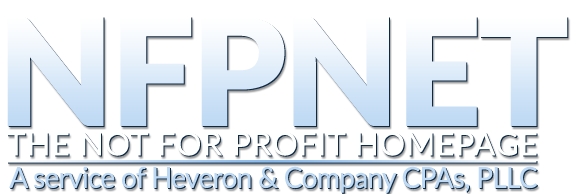Tag Archive for: nonprofit
Spring 2019 Newsletter
Download the complete newsletter HERE
INSIDE THIS ISSUE
- What Makes Affordable Housing a Charitable Activity?
- Candid: The merger and rebranding of The Foundation Center and Guidestar
- IRS Audit Targets for 2019
- Nonprofit Inflation Adjustments for 2019
- How to Develop a Dashboard Report for Your Board
- WebStar Winner: New York State Charities Bureau
Download the complete newsletter HERE
Affordable Housing-Paying for Your Section 168(h) Election
When a nonprofit is involved in an affordable housing or similar project with a for profit investor, the nonprofit generally uses a taxable for profit subsidiary to hold the property. The benefit of this is that the property can be depreciated over 27 ½ years rather than 40 years, which means a better tax results for the investor, and translates to a higher price for the tax credits.
However, to get this treatment the taxable subsidiary must make an election under Internal Revenue Code section 168(h)(6)(F)(ii). The effect of this election is that
dividends or interest, paid from the taxable subsidiary to the nonprofit parent, are taxable as Unrelated Business Income.
This requirement only exists when not all tax attributes between the project and its owners (share of income and loss, distributions, equity) are the same. But, that usually is the case for these joint venture projects
Additionally, any gain from disposition of an interest in the taxable subsidiary is also taxable as Unrelated Business Income to the nonprofit.
Techniques for reducing tax on dividends, interest or dispositions include, first repaying all loans and developer fees to the nonprofit sponsor. Additionally, the entity holding the project (usually a limited partnership) can make payments directly to the nonprofit as reimbursement for expenses. However, the nonprofit needs to document that these expenses are costs the nonprofit has incurred in behalf of the project.
Examples of allowable costs include payroll and related taxes, and benefits, as well as indirect costs that are necessary for providing services to the project. Indirect costs typically include items such as occupancy, insurance, general accounting, and administration.
Changes in Your Legal Form
If a charity changes its incorporation from one state to another or makes a similar significant change to its legal entity, but no changes to its operations, it generally had to apply for exempt status much like a new organization. IRS made that process significantly easier with the new procedure known as Revenue Procedure 2018-15.
The Revenue Procedure allows an organization to migrate its nonprofit status to the new legal entity when there are no significant changes in the organization’s operations.
We had a chance to try the new procedure recently for an organization that had a flaw in its original incorporation document. The organization needed to form a new corporation with a slightly different name. We were successful in getting exempt status transitioned to the new organization without a new application for exemption.
Check the Revenue Procedure online or contact us for information about how this procedure works and when it applies.
The Other Public Support Test – the 10% Facts and Circumstances Test
The 10% De Minimis Indirect Cost Rate-Not All It’s Cracked up to Be
Spring 2018 Newsletter
Download the complete newsletter HERE
INSIDE THIS ISSUE:
• How the New Tax Laws Affect Nonprofits
• Stephanie Annunziata, CPA, presents a nonprofit update to the Monroe County Bar Association
• Leading with Intent: a BoardSource Report
• Volunteering Out of Unrelated Business Income Taxation
• How the New Federal Tax Law Affects Affordable Housing
• The Best Board Meeting Ever!
• WebStar Winner
Download the complete newsletter HERE
How the New Tax Law Affects Nonprofits
The recently enacted tax law has both direct and indirect effect on nonprofits. The indirect effect is the decreased tax incentive for charitable contributions that results from doubling the standard deduction, decreasing individual and corporate tax rates, and increasing the estate tax exemption. It is difficult to know how these will affect charitable giving, but the huge increase in online giving at year-end (The Chronicle of Philanthropy reported that online donors gave 38% more to charities during the last week of 2017 than in the last week of 2016) indicates that tax incentives do impact charitable giving. The fact that individuals can now deduct cash contributions to qualified charities up to 60% of adjusted gross income (previously 50%) isn’t likely to do much to offset these disincentives.
Unrelated Business Income
Although lower rates will apply to nonprofits paying unrelated business income tax, a new provision restricts losses from one unrelated activity from being offset against other activities.
Unrelated Business Income Taxation will also be applied to certain fringe benefits paid for by tax exempt organizations for qualified transportation fringe benefits, or for on -premises athletic facilities. There is also an excise tax on certain nonprofit salaries exceeding $1 million.
Moving Expense Deductibility
If your organization pays moving expenses for new or current employees, these are no longer excludable from taxable income. This may require nonprofit employers to pay more to make their employees “whole”.
Provisions That Did Not Make It into the Final Law
Several provisions did not make it into the final law, including:
repeal of the Johnson amendment,
changes to private foundation excise taxes,
reductions to qualified tuition plans and employer-provided educational assistance,
taxing the value of housing for the convenience of the employer,
unrelated business income tax on royalties from licensing an exempt organization’s name, and from research activities where results were not made publicly available,
enhanced donor advised fund reporting, and
taxing interest on certain private activity bonds.
